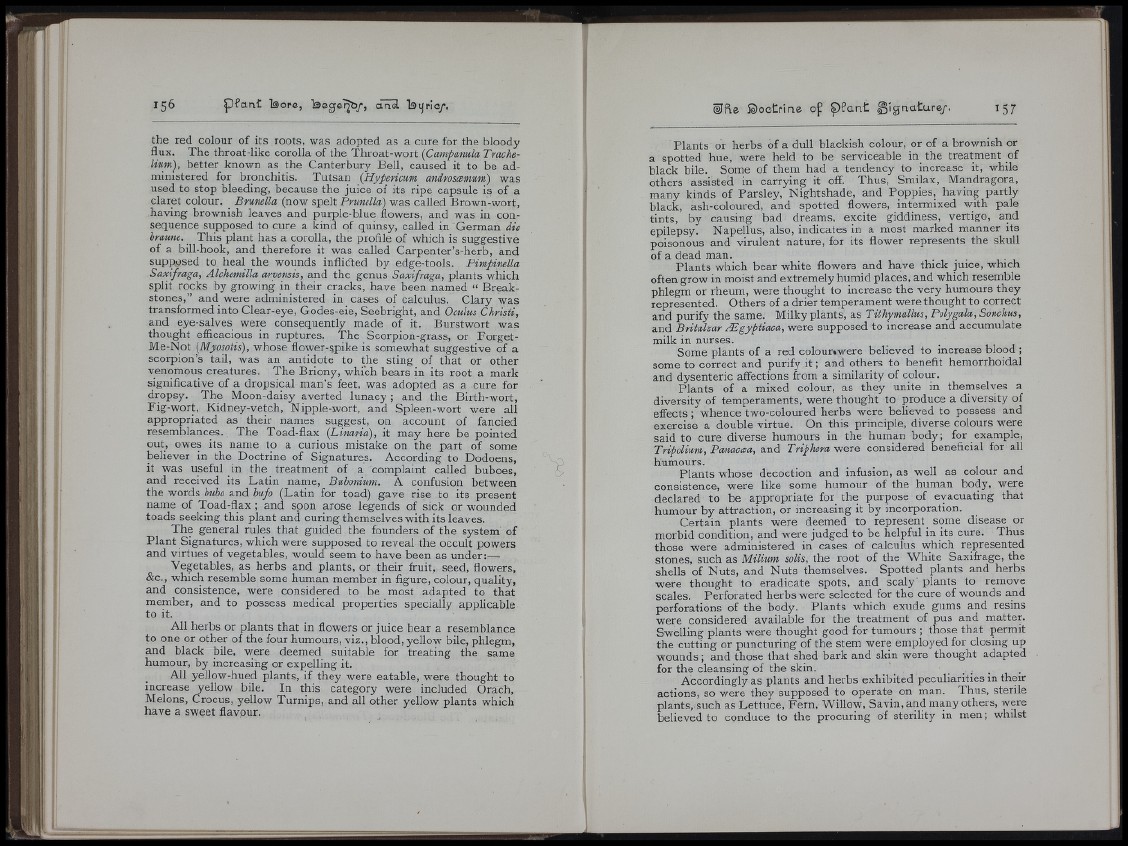
I;
1 5 6 p F a a t Tsor©, "beg©?^/, cmsl T0ijpiq/*, ^R© ©ootp'm© of p F a n t g ign a tu p© /, 1 5 7
} i
I ,, :1 11 i 1;
I
1/ Mr i
(
the red colour of its roots, was adopted as a cure for the bloody
flux. The throat-like corolla of the Throat-wort {Campanula Tmche-
lium), better known as the Canterbury Bell, caused it to be administered
for bronchitis. Tutsan [Hypericum androsamum) was
used to stop bleeding, because the juice of its ripe capsule is of a
claret colour. Brunella (now spelt Prunella) was called Brown-wort,
having brownish leaves and purple-blue flowers, and was in consequence
supposed to cure a kind of quinsy, called in German die
braune. This plant has a corolla, the profile of which is suggestive
of a bill-hook, and therefore it was called Carpenter’s-herb, and
supposed to heal the wounds inflidled by edge-tools. Pimpinella
Saxifraga, Alchemilla arvensis, and the genus Saxifraga, plants which
split rocks by growing in their cracks, have been named “ Breakstones,”
and were administered in cases of calculus. Clary was
transformed into Clear-eye, Godes-eie, Seebright, and Oculus Christi,
and eye-salves were consequently made of it. Burstwort was
thought efficacious in ruptures. The Scorpion-grass, or Forget-
Me-Not [Myosotis), whose flower-spike is somewhat suggestive of a
scorpion’s tail, was an antidote to the sting of that or other
venomous creatures. The Briony, which bears in its root a mark
significative of a dropsical man’s feet, was adopted as a cure for
dropsy. The Moon-daisy averted lu n a cy ; and the Birth-wort,
Fig-wort, Kidney-vetch, Nipple-wort, and Spleen-wort were all
appropriated as their names suggest, on account of fancied
resemblances. The Toad-flax [Linaria), it may here be pointed
out, owes its name to a curious mistake on the part of some
believer in the Doctrine of Signatures. According to Dodoens,
it was useful in the treatment of a complaint called buboes,
and received its Latin name, Bubonium. A confusion between
the words bubo and bufo (Latin for toad) gave rise to its present
name of Toad-flax ; and soon arose legends of sick or wounded
toads seeking this plant and curing themselves with its leaves.
The general rules that guided the founders of the system of
Plant Signatures, which were supposed to reveal the occult powers
and virtues of vegetables, would seem to have been as under:—
Vegetables, as herbs and plants, or their fruit, seed, flowers,
&c., which resemble some human member in figure, colour, quality,
and consistence, were considered to be most adapted to that
member, and to possess medical properties specially applicable
to it.
All herbs or plants that in flowers or juice bear a resemblance
to one or other of the four humours, viz., blood, yellow bile, phlegm,
and black bile, were deemed suitable for treating the same
humour, by increasing or expelling it.
All yellow-hued plants, if they were eatable, were thought to
increase yellow bile. In this category were included Orach,
Melons, Crocus, yellow Turnips, and all other yellow plants which
have a sweet flavour.
Plants or herbs of a dull blackish colour, or of a brownish or
a spotted hue, were held to be serviceable in the treatment of
black bile. Some of them had a tendency to increase it, while
others assisted in carrying it off. Thus, Smilax, Mandragora,
many kinds of Parsley, Nightshade, and Poppies, having partly
black, ash-coloured, and spotted flowers, intermixed with pale
tints, by causing bad dreams, excite giddiness, vertigo, and
epilepsy. Napellus, also, indicates in a most marked manner its
poisonous and virulent nature, for its flower represents the skull
of a dead man.
Plants which bear white flowers and have thick juice, which
often grow in moist and extremely humid places, and which resemble
phlegm or rheum, were thought to increase the very humours they
represented. Others of a drier temperament were thought to correct
and purify the same. Milky plants, as Tithymallus, Polygala, Sonchus,
and Britalzar .¿Egyptiaca, were supposed to increase and accumulate
milk in nurses.
Some plants of a red colour »were believed to increase blood;
some to correct and purify i t ; and others to benefit hemorrhoidal
and dysenteric affections from a similarity of colour.
Plants of a mixed colour, as they unite in themselves a
diversity of temperaments, were thought to produce a diversity of
effects ; whence two-coloured herbs were believed to possess and
exercise a double virtue. On this principle, diverse colours were
said to cure diverse humours in the human body; for example,
Tripolium, Panaccea, and Triphera were considered beneficial for all
humours.
Plants whose decoction and infusion, as well as colour and
consistence, were like some humour of the human body, were
declared to be appropriate for the purpose of evacuating that
humour by attraction, or increasing it by incorporation.
Certain plants were deemed to represent _ some disease or
morbid condition, and were judged to be helpful in its cure. Thus
those were administered in cases of calculus which represented
stones, such as Milium solis, the root of the White Saxifrage, the
shells of Nuts, and Nuts themselves. Spotted plants and herbs
were thought to eradicate spots, and scaly plants to remove
scales. Perforated herbs were selected for the cure of wounds and
perforations of the body. Plants which exude gums and resins
were considered available for the treatment of pus and matten
Swelling plants were thought good for tumours; those that permit
the cutting or puncturing of the stem were employed for closing up
wounds ; and those that shed bark and skin were thought adapted
for the cleansing of the skin.
Accordingly as plants and herbs exhibited peculiarities in their
actions, so were they supposed to operate on man. Thus, sterile
plants, such as Lettuce, Fern, Willow, Savin, and many others, were
believed to conduce to the procuring of sterility in men; whilst